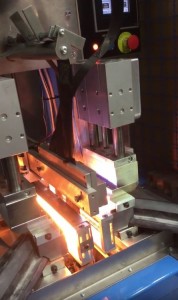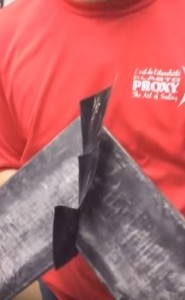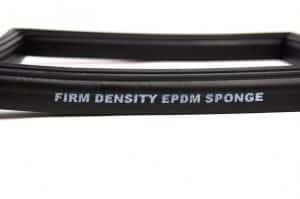
Infrared splicing provides a cost-effective alternative to rubber molding for larger gaskets. Plus, this innovative splicing technique is faster and more energy-efficient than hot splicing.
Infrared splicing uses infrared (IR) light and polyethylene (PE) film to join lengths of rubber into custom gaskets. A form of electromagnetic radiation, IR emits heat that melts or softens the film’s adhesive, which is typically acrylic. This permanent adhesive sticks to each length of rubber, and the film joins the two pieces together with strong, reliable bonds that resist water and weather. Applications for IR spliced gaskets include the rubber gate seals used in water treatment facilities.
How Infrared Splicing Works
Infrared splicing is a semi-automatic process that’s performed on a single-unit joining press. At Elasto Proxy, our IR splicing machine features a distance knife, infrared heating elements, splicing mold, foot pedal, and digital display. PE film is fed from a roll, cut with the knife, and heated with IR light. The infrared splicer that we use supports PE films with a width of 50, 60, or 70 mm and a thickness of 75 to 300 grams. Watch this YouTube video to see how our skilled production personnel create IR spliced gaskets.
Infrared Splicing vs. Hot Splicing
Infrared splicing uses heat, but this bonding method is different than hot splicing, a traditional joining process that requires both heat and pressure. With traditional hot splicing equipment, a heated clamp holds the PE film and the rubber pieces in place. Heating the surface of the clamping mold is energy-intensive, and hot splicing requires longer cure times. That’s why some hot splicers have multiple units in a line or carousel formation to support production efficiency.
https://www.youtube.com/watch?v=SrRfbfCI6
More Advantages of Infrared Splicing

Unlike cold bonding, another gasket joining technique, infrared splicing eliminates time-consuming, manual operations that can introduce inconsistencies. IR splicing also supports precise part alignments without degrading PE films. Plus, infrared splicing makes it easier to work with large, complex shapes. IR splicing molds are wider than the clamps used with hot splicers, too. This lets our IR splicer machine operators make three or four splices at a time instead of just one or two. Again, this video shows how.
Applications for Infrared Splicing
In addition to the rubber gate seals used in water treatment facilities, infrared splicing is used to create strong corners and with other types of large gaskets. Importantly, IR splicing also provides a cost-effective alternative to molded rubber parts. Techniques such as injection molding, liquid injection molding, compression molding, and transfer molding are economical in high volumes, but can be cost-prohibitive in low-to-medium quantities.
How Can We Help You?
Elasto Proxy offers different splicing techniques to create rubber parts such as hollow O-rings, low-closure force seals, and large-diameter profiles that are too expensive to mold. Splicing methods vary, and choices include film splicing, cold bonding, C-press injection molding, and vulcanizing. By working with our solutions providers, you can select the right splicing technique for your application.
Is infrared splicing the right joining technique for the rubber gaskets that you need? Contact us.










